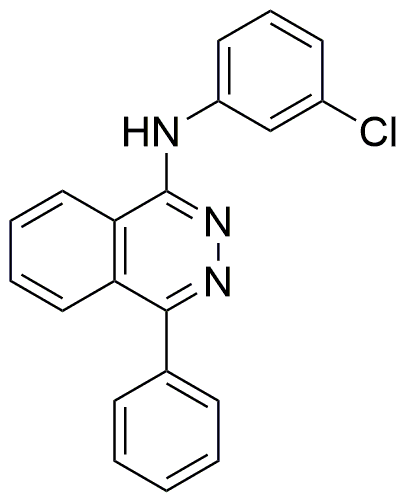1-(3-Chloroanilino)-4-phenylphthalazine is widely utilized in research focused on:
- Pharmaceutical Development: This compound serves as a key intermediate in the synthesis of various pharmaceuticals, particularly in the development of anti-cancer agents, enhancing therapeutic efficacy.
- Material Science: It is used in the formulation of advanced materials, including polymers and coatings, due to its ability to improve thermal stability and mechanical properties.
- Analytical Chemistry: The compound is employed in analytical methods for detecting and quantifying other chemicals, providing reliable results in environmental monitoring.
- Biological Research: Researchers utilize it in studies related to enzyme inhibition and receptor binding, contributing to the understanding of biological pathways and disease mechanisms.
- Colorant Production: It is also involved in the manufacturing of dyes and pigments, offering vibrant colors and stability for various industrial applications.
Información general
Propiedades
Seguridad y normativas
Aplicaciones
1-(3-Chloroanilino)-4-phenylphthalazine is widely utilized in research focused on:
- Pharmaceutical Development: This compound serves as a key intermediate in the synthesis of various pharmaceuticals, particularly in the development of anti-cancer agents, enhancing therapeutic efficacy.
- Material Science: It is used in the formulation of advanced materials, including polymers and coatings, due to its ability to improve thermal stability and mechanical properties.
- Analytical Chemistry: The compound is employed in analytical methods for detecting and quantifying other chemicals, providing reliable results in environmental monitoring.
- Biological Research: Researchers utilize it in studies related to enzyme inhibition and receptor binding, contributing to the understanding of biological pathways and disease mechanisms.
- Colorant Production: It is also involved in the manufacturing of dyes and pigments, offering vibrant colors and stability for various industrial applications.
Documentos
Hojas de datos de seguridad (HDS)
La SDS proporciona información de seguridad completa sobre la manipulación, el almacenamiento y la eliminación del producto.
Especificación del producto (PS)
La PS proporciona un desglose completo de las propiedades del producto, incluida la composición química, el estado físico, la pureza y los requisitos de almacenamiento. También detalla los rangos de calidad aceptables y las aplicaciones previstas del producto.
Certificados de análisis (COA)
Busque certificados de análisis (COA) ingresando el número de lote del producto. Los números de lote y de partida se pueden encontrar en la etiqueta de un producto después de las palabras "Lote" o "Lote".
Número de catálogo
Número de lote/lote
Certificados de origen (COO)
Este certificado de origen confirma el país en el que se fabricó el producto y también detalla los materiales y componentes utilizados en él y si se deriva de fuentes naturales, sintéticas u otras fuentes específicas. Este certificado puede ser necesario para cumplir con las normativas aduaneras, comerciales y regulatorias.
Número de catálogo
Número de lote/lote
Hojas de datos de seguridad (HDS)
La SDS proporciona información de seguridad completa sobre la manipulación, el almacenamiento y la eliminación del producto.
DownloadEspecificación del producto (PS)
La PS proporciona un desglose completo de las propiedades del producto, incluida la composición química, el estado físico, la pureza y los requisitos de almacenamiento. También detalla los rangos de calidad aceptables y las aplicaciones previstas del producto.
DownloadCertificados de análisis (COA)
Busque certificados de análisis (COA) ingresando el número de lote del producto. Los números de lote y de partida se pueden encontrar en la etiqueta de un producto después de las palabras "Lote" o "Lote".
Número de catálogo
Número de lote/lote
Certificados de origen (COO)
Este certificado de origen confirma el país en el que se fabricó el producto y también detalla los materiales y componentes utilizados en él y si se deriva de fuentes naturales, sintéticas u otras fuentes específicas. Este certificado puede ser necesario para cumplir con las normativas aduaneras, comerciales y regulatorias.


